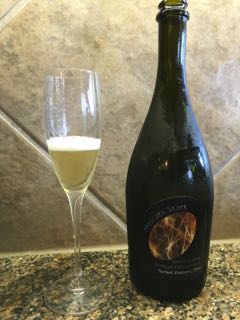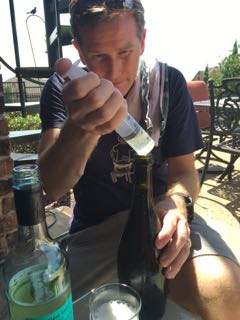So I just finished a fun project and wanted to share my method from start to finish.
My wife enjoys prosecco which she often mixes with juices for a refreshing drink. I decided that I would try to make some sparkling wine and riddle and disgorge the yeast as well.
I used a 1 gallon World Vineyard Moscato Wine kit. Below are the steps that I took and modifications made to make the sparkling wine.
February 1
Added Juice and F-Pack to a fermentation bucket. Added enough water to get a starting gravity of 1.078. I used 1 package of EC-1118 instead of the yeast provided with the kit.
February 17
Added a 1/4 of a Campden Tablet and Isinglass
February 29
Racked the wine to a bottling bucket and added 2.25oz of Dextrose and 1 package of EC-1118. I had enough wine to bottle 5 750ml bottles and a small swing top bottle.
The 750ml bottles were prosecco bottles that I had saved. I capped the bottles which required the larger european caps.
I then laid the bottles on their side and let them re-ferment for 2 months.
After 2 months, I chilled and opened the small swing top bottle. The wine was carbonated so I turned the 5 champagne bottles upside down (cap end down). For about a week, I would daily swirl the bottles to help the yeast to settle to the neck of the bottle.
May 20
I moved the still upside bottles of sparkling wine to the refrigerator and let them chill to settle as much yeast out as possible.
May 29
The fun part. I'm in Texas and we can buy 190 proof alcohol, I'm sure 151 proof alcohol would also work. Also, picked up some dry ice from the grocery store. In a small container we mixed some of the grain alcohol and chopped up dry ice. This worked perfect to freeze the yeast plug in a couple of minutes. We then used a bottle opener to pop the cap off and then the pressure would shoot the yeast plug. With some bottles the plug and wine were a little too frozen and nothing would happen for a few seconds until things thawed a little bit. Also sometimes some frozen yeast sediment would remain in the neck of the bottle. We would just pick this out with a small spoon. I topped off the bottle with some fresh store bought Moscato wine using a syringe and pouring the wine along the side of the bottle to not cause loss of CO2. Then used plastic champagne corks and wire cages.
June 4
Today we popped our first bottle to try and things taste pretty good. My wife is happy so I consider it to be a complete success.
http://www.brewerylane.com/wine/sparkling-wine-champagne-method.html
This is article that I used to help me do this project.
I primarily brew beer so with my knowledge learned I'll apply this to making a Methode Champenoise beer similar to the Belgian beer Deus.





My wife enjoys prosecco which she often mixes with juices for a refreshing drink. I decided that I would try to make some sparkling wine and riddle and disgorge the yeast as well.
I used a 1 gallon World Vineyard Moscato Wine kit. Below are the steps that I took and modifications made to make the sparkling wine.
February 1
Added Juice and F-Pack to a fermentation bucket. Added enough water to get a starting gravity of 1.078. I used 1 package of EC-1118 instead of the yeast provided with the kit.
February 17
Added a 1/4 of a Campden Tablet and Isinglass
February 29
Racked the wine to a bottling bucket and added 2.25oz of Dextrose and 1 package of EC-1118. I had enough wine to bottle 5 750ml bottles and a small swing top bottle.
The 750ml bottles were prosecco bottles that I had saved. I capped the bottles which required the larger european caps.
I then laid the bottles on their side and let them re-ferment for 2 months.
After 2 months, I chilled and opened the small swing top bottle. The wine was carbonated so I turned the 5 champagne bottles upside down (cap end down). For about a week, I would daily swirl the bottles to help the yeast to settle to the neck of the bottle.
May 20
I moved the still upside bottles of sparkling wine to the refrigerator and let them chill to settle as much yeast out as possible.
May 29
The fun part. I'm in Texas and we can buy 190 proof alcohol, I'm sure 151 proof alcohol would also work. Also, picked up some dry ice from the grocery store. In a small container we mixed some of the grain alcohol and chopped up dry ice. This worked perfect to freeze the yeast plug in a couple of minutes. We then used a bottle opener to pop the cap off and then the pressure would shoot the yeast plug. With some bottles the plug and wine were a little too frozen and nothing would happen for a few seconds until things thawed a little bit. Also sometimes some frozen yeast sediment would remain in the neck of the bottle. We would just pick this out with a small spoon. I topped off the bottle with some fresh store bought Moscato wine using a syringe and pouring the wine along the side of the bottle to not cause loss of CO2. Then used plastic champagne corks and wire cages.
June 4
Today we popped our first bottle to try and things taste pretty good. My wife is happy so I consider it to be a complete success.
http://www.brewerylane.com/wine/sparkling-wine-champagne-method.html
This is article that I used to help me do this project.
I primarily brew beer so with my knowledge learned I'll apply this to making a Methode Champenoise beer similar to the Belgian beer Deus.








